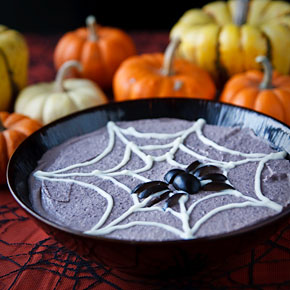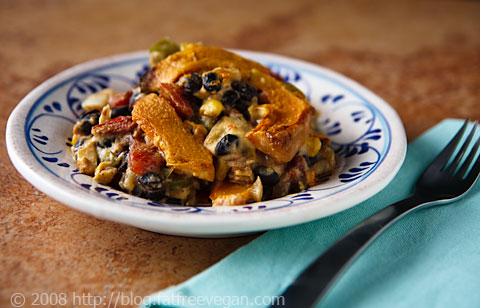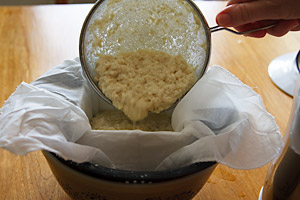Pumpkin Cookies
 What I love most about sharing recipes online is the conversation that follows, when readers share their tips and variations. I'm constantly getting ideas from you: ingredients I haven't tried, short-cuts that make a recipe faster, substitutions I've never thought of. Case in point, this email I received earlier this week from Emily Findley in Michigan:
What I love most about sharing recipes online is the conversation that follows, when readers share their tips and variations. I'm constantly getting ideas from you: ingredients I haven't tried, short-cuts that make a recipe faster, substitutions I've never thought of. Case in point, this email I received earlier this week from Emily Findley in Michigan:So i am OBSESSED with your okara cookies! When I first read the recipe I couldn't help drooling but then I realized I didn't have any coconut! So what did I decide to do? Use pumpkin puree! Yup, I've made pumpkin okara cookies, substituting pumpkin puree for the coconut flakes and using more vanilla extract rather than any coconut extract....I also add a handful of oatmeal for a little extra crunch.
I was immediately intrigued. I've been in a pumpkin-cookin' mood lately, but pumpkin cookies hadn't even occurred to me. I had to check them out. As it turns out, I wound up making two versions of these delicious cookies!
Following Emily's lead, I substituted pumpkin for the coconut and added a little oatmeal for texture. Emily had used honey instead of sugar, so I decided to use agave nectar for sweetening. She also prescribed adding lots of spices, which add a pumpkin pie-taste to these fabulous treats. To make them a little sweeter and more kid-friendly, I iced half of the cookies with pumpkin-colored frosting. It worked! My daughter immediately claimed all of the frosted cookies as "hers." She liked them so much that she would have eaten all of them in one sitting if I'd let her.

Fat-Free Pumpkin Cookies
(printer-friendly version)
1/2 cup whole wheat flour (I used white whole wheat flour)
1/2 cup unbleached flour
1/4 cup rolled oats
1/2 teaspoon baking soda
1 teaspoon cinnamon
1/2 teaspoon ginger
1/4 teaspoon nutmeg
1/4 teaspoon salt
1/2 cup agave nectar
1/2 cup canned pumpkin
2/3 cup okara (or 8 ounces firm tofu, blended in a food processor until smooth)
1 teaspoon vanilla extract
1 tablespoon turbinado sugar -- or icing, below
Preheat oven to 375F.
Mix the flours, oats, baking soda, spices, and salt in a mixing bowl. Mix the agave nectar, pumpkin, okara (tofu), and vanilla in another bowl. Add the wet ingredients to the dry and stir just until well-blended. Do not over-stir.
Use a cookie scoop or tablespoon to drop rounded tablespoons of dough at least two inches apart on a baking sheet lined with a silicone baking mat or parchment paper. Flatten each cookie slightly with a fork. Sprinkle with turbinado sugar, if desired. Bake for 10-16 minutes or until edges are golden and middles seem done. Remove from oven and allow to cool for 5 minutes before transferring each cookie to a wire rack. Allow to cool completely before serving.
Optional icing:
1 cup confectioners' sugar
2 teaspoons agave nectar
2 teaspoons non-dairy milk
1/4 teaspoon vanilla extract or other extract (I used pecan)
food coloring (optional)
In a small mixing bowl, add the agave nectar, milk, and extract to the confectioners' sugar. Add additional milk a half-teaspoon at a time, stirring constantly, until the icing is smooth and spreadable but not so thin that it runs off. If you add too much milk, add a little more sugar to balance it out. Add food coloring a drop at a time until the right color is achieved. Spread over cooled cookies and allow to dry.
Makes about 15 cookies. Per cookie (with sugar, no icing) : 76 Calories (kcal); trace Total Fat; (3% calories from fat); 1g Protein; 18g Carbohydrate; 0mg Cholesterol; 78mg Sodium; 1g Fiber. Weight Watchers: 1 Point.
With icing: 110 Calories (kcal); trace Total Fat; (2% calories from fat); 1g Protein; 27g Carbohydrate; 0mg Cholesterol; 78mg Sodium; 1g Fiber. Weight Watchers: 2 Points.
Fat-free cookies are fine for here at home, but I'm always afraid they're a little too rubbery to serve to people who aren't used to fat-free baking. When I'm entertaining or bringing food to a party, I like to avoid serving anything that tastes too "healthy" because people will get the (wrong) idea that it tastes that way because it's vegan when, in fact, it's the lack of fat that makes it heavier and chewier. So while I had the oven hot and my counters all covered with flour and pumpkin, I made a second, not fat-free version using 1/3 cup of Earth Balance margarine instead of half of the okara. The results were amazing--light, tender cookies that melt in your mouth. And since I added extra sugar to the batter, they don't need any icing or sugar on top, though a little orange icing would make them perfect at any Halloween party. But please don't present them as health food!

Pumpkin Cookies
(printer-friendly version)
1/2 cup whole wheat flour (I used white whole wheat flour)
1/2 cup unbleached flour
1/4 cup rolled oats
1/2 teaspoon baking soda
1 teaspoon cinnamon
1/2 teaspoon ginger
1/4 teaspoon nutmeg
1/8 teaspoon cloves
1/4 teaspoon salt
1/3 cup Earth Balance Margarine, softened
1/4 cup brown sugar
1/2 cup sugar
1/3 cup okara (or 4 ounces firm tofu, blended in a food processor until smooth)
1/2 cup canned pumpkin
1 teaspoon vanilla extract
Preheat oven to 375F.
Mix the dry ingredients (flour through salt) in a medium bowl. In a large bowl, cream together the margarine and sugar. Beat in the okara, pumpkin, and vanilla extract, until well-blended.
Add the flour mixture a little at a time to the wet ingredients, stirring well after each addition. Use a cookie scoop or tablespoon to drop rounded tablespoons of dough at least two inches apart on a baking sheet lined with a silicone baking mat or parchment paper. Bake for 10-14 minutes. Remove from oven and allow to cool for 5 minutes before transferring to a wire rack to cool completely.
Makes about 15 cookies. Per cookie: 109 Calories (kcal); 4g Total Fat; (35% calories from fat); 1g Protein; 17g Carbohydrate; 0mg Cholesterol; 122mg Sodium; 1g Fiber. Weight Watchers: 2 Points.
Thanks, Emily, for the great idea and for allowing me to share it with everyone. Now, could someone get me away from all these cookies?!
Before I forget:
Cathleen at Vegan Nutritionista recently asked me to answer a few questions about my experience as a vegan. You can check out the interview here.
Labels: higher-fat, holidays, soy









 I have two standard Halloween recipes in my,
I have two standard Halloween recipes in my, 
 I don't know what happened to revolutionize the way whole wheat pasta is produced, but something must have. It's evolved, in my opinion, from a heavy, grainy-tasting, fall-apart-if-you-slightly-overcook-it
I don't know what happened to revolutionize the way whole wheat pasta is produced, but something must have. It's evolved, in my opinion, from a heavy, grainy-tasting, fall-apart-if-you-slightly-overcook-it 



 October may seem like a strange time to be writing about salads, but even in the cooler months, I like to eat salads for lunch. I load up on raw vegetables for my midday meal and concentrate on cooked veggies, beans, and grains for dinner. But raw vegetables don't really fill me up or keep me going all afternoon; I need something with staying power. That's where chickpea salads come in. Served atop a big salad of lettuce, spinach, cucumber, and tomatoes, they add flavor and texture as well as protein.
October may seem like a strange time to be writing about salads, but even in the cooler months, I like to eat salads for lunch. I load up on raw vegetables for my midday meal and concentrate on cooked veggies, beans, and grains for dinner. But raw vegetables don't really fill me up or keep me going all afternoon; I need something with staying power. That's where chickpea salads come in. Served atop a big salad of lettuce, spinach, cucumber, and tomatoes, they add flavor and texture as well as protein.


 Some tourists visit places of scenic beauty, others seek out man-made wonders like cathedrals and museums, but when I travel, I look for... grocery stores!
Some tourists visit places of scenic beauty, others seek out man-made wonders like cathedrals and museums, but when I travel, I look for... grocery stores!















